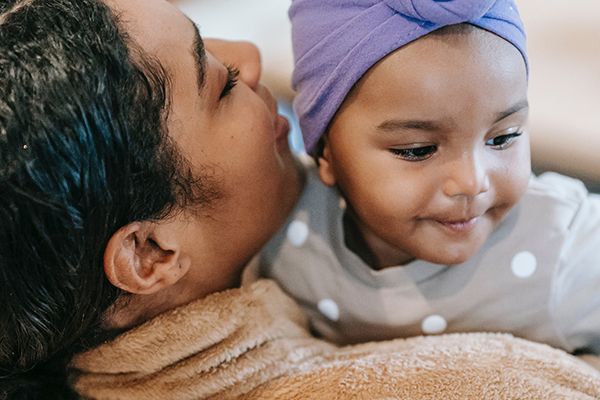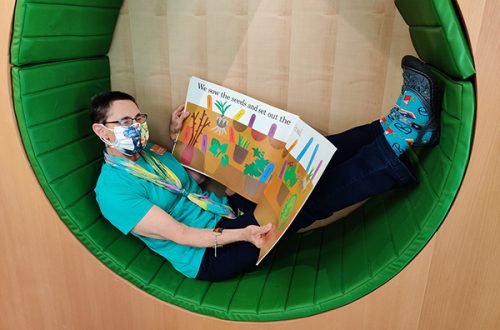
Your Baby’s Brain is Hooked Up for Music
By Sue Doherty

Babies listen to our unique way of speaking to them, known as motherese or parentese. The distinguishing characteristic is the singsong emotive quality we place on our words.
How do a baby’s senses begin to integrate, cooperate, and collaborate in the brain? Amazingly, newborns as young as 2 days old can decipher pitch. Rocking to the beat is innate. István Winkler and Henkjan Honing discovered that babies can detect the rhythmic beat in drumming-infused rock music. They believe that evolution may have favored brains wired to rock for learning purposes, and, he suggests: “music went along for the ride.”
A baby’s brain is busy recognizing a pattern and making predictions relative to that pattern—if a prediction is faulty, it activates an error signal. Babies listen to our unique way of speaking to them, known as motherese or parentese. The distinguishing characteristic is the singsong emotive quality we place on our words. Infants can pick up vocal and non-vocal cues and patterns, which allows them to make sense of the general meaning of our words. Likewise, with musical perceptions, 5-month olds can tell apart an upbeat tune compared to a sad one.
Moving to music in infancy can shape neural responses to musical rhythm and plasticity in neural networks. Weak connectivity between infants’ sensorimotor systems (e.g., auditory-motor-vestibular) and plasticity in the auditory system provides insight into perceptual preferences around music-movement interactions. Jessica Phillips-Silver and Laurel J. Trainor tested seven-month-old infants at their baby lab at McMaster University in Canada. They discovered that the movement of the head and activating of the vestibular system, more than the limbs, cause metrical encoding to occur.
Even premature babies find enormous benefits from hearing live music being played or sung. Eleven hospitals did a collaborative music therapy study led by Beth Israel Medical Center in New York. They found it helped premature infants reduce stress and stabilize vital signs. Turning parents’ favorite tunes into lullabies calmed the preemies’ breathing and heartbeat, fostered greater ease while sucking, facilitated sleep, and encouraged alertness. Some hospitals participating in the study found that music therapy is a legitimate alternative to sedating, safer, and just as effective. All this, in turn, reduces parental stress and anxiety. Dancing is now recommended for the same reasons, it’s part of Mother-Baby Interaction Therapy. These benefits allow an infant’s much-needed energy reserves to go toward typical development.
The calming effect the music therapists imparted has also been observed while just picking up a baby and moving. Research showed that infants under 6 months of age carried by a walking mother immediately stopped voluntary movement and crying. In addition, their rapid heart rate decreased, compared to being held by a sitting mother. Thus, the infant’s calming response to maternal carrying is a conserved component of mammalian mother-infant interactions. As one of the lead authors, Kuroda, suggests: “A scientific understanding of this infant response will save parents from misreading the restart of crying as the intention of the infant to control the parents, as some parenting theories—such as the ‘cry it out’ type of strategy—suggest. Rather, this phenomenon should be interpreted as a natural consequence of the infant sensorimotor systems.”
Indeed, the sensorimotor system is vital to our very consciousness. Sensory strategies or perceptual styles aid in our understanding of the neural mechanisms of self-consciousness. Attachment quality predicts individual differences in the onset of gaze following. For example, maternal postpartum depression predicts later gaze following. Kim Astor and colleagues found that this is driven by the infant’s motivation to interact and engage with others (the social-first perspective). Indeed, some scientists are calling for a paradigm shift that recognizes the importance of embodied cognition.
So as we interact with our baby, perhaps dancing, our baby moves along with us. A self-identification unfolds because of social-emotional channels coupled with visual, gravitational, and vestibular sensory signals. As Christian Pfeiffer et al. conclude: “….the experienced direction of the first-person perspective depends on the integration of visual, vestibular, and tactile signals, as well as on individual differences in idiosyncratic visual-vestibular strategies.”
Our connective tissue, known as the facia, could be viewed as the largest sensory organ in your body. According to Dr. Arielle Schwartz, tissue contains 250 million nerve endings. This amounts to three times as many sensory neurons as motor neurons. The function of the fascia is to communicate information about what’s happening in your body to your brain. The tissues of the fascia are meant to expand and contract. However, Dr. Schwartz explains, “when we have experienced a physical injury or emotional trauma, we tend to shock, which restricts movement to ensure our survival. Simply put, we either move into either freeze (tonic immobility) or faint (collapsed immobility) responses.”
For most people who grow up with sensory issues, their discomfort will diminish significantly or resolve on their own with maturation. However, Wendy Nash, MD, a child and adolescent psychiatrist at the Child Mind Institute, explains that issues associated with autism tend to last longer but still show improvement. Some susceptible children may become overwhelmed by sensory input, which leads to avoidance. While other kids crave stimulation. These children intentionally seek stimulation; they might swing or spin around excessively or push into things (and people). Others may yo-yo back and forth between seeking and avoiding various kinds of sensory input. For example, some children will want the pressure of sitting on a large ball, bouncing and twisting; they may like deep massage-like sensations or the weight of a heavily weighted blanket. Others will prefer dim light or don headphones to escape loud sounds or wear specific clothing with tags removed. The rubrics cube and squeezy objects help the fidgets. Also, mindfulness breathing practices, playing instruments requiring breathwork, or sucking into a straw may help calm the revved-up child. What if each school child had space in a cubby or locker with their own preferred supplies for self-regulation? Perhaps a weighted or unweighted blanket to be used during mindful sitting practice. All these points to the importance of recess and P.E. Physical fitness and regulation are life-long skill sets. Maturation matters to the integration of sensory processing and social-emotional systems.
The argument made is that learning sensorimotor contingencies is a core feature of development–forming the basis for active exploration of the world and body. According to Gustaf Gredebäck, there are 6 core developmental pathways children use to solve unique challenges; these include capacities for:
- Simulating action allowing anticipation of activities,
- Controlling reaching and grasping,
- Exploring the self and the environment,
- Embodying error-based learning,
- Acquiring language by social engagement and
- Comprehending gestures.
In the end, nature and nurture co-mingle. DNA can predict traits like sociability, activity level, and emotionality–but they are not destiny. Personality is changeable throughout the lifespan. So, as geneticist Robert Plomin urges, find out what your child likes to do and help them do it.
Sue Doherty, M.A., is an anthropologist, mindfulness teacher certified through the Greater Good Science Center, U. C. Berkeley, and the author of Dancing With Your Baby—The Science of Nurturing Infant and Caregiver through Music and Movement (available at Bookshop Santa Cruz or Amazon). You can email: [email protected]


You May Also Like

Fourth of July
July 1, 2021
Capitola Library
June 29, 2021

